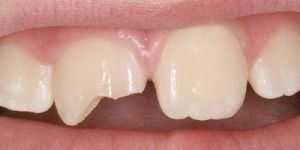 Certain provoking factors can result in a tooth injury, which, depending on the complexity of the particular case, is a violation of the integrity of the tooth itself and( or) the tissues that are located next to it.
Certain provoking factors can result in a tooth injury, which, depending on the complexity of the particular case, is a violation of the integrity of the tooth itself and( or) the tissues that are located next to it.
In some cases, its functionality may be completely lost.
Contents
- Prognostic factors
- Classification system used by WHO specialists
- Symptomatics and treatment of injuries
- Diagnosis and therapy methods
- Dislocations from mechanical impact
- Diagnosis and treatment
- Fractures - complete and incomplete
- Characteristic symptoms
- Diagnosis and treatment approach
- Consequencesand preventive measures
Aggravating factors
Causes that can cause tooth trauma quite a lot. This can be a momentary impact, that is, a blow, a fall, a fight, an accident and other circumstances, when the pressure on the tooth occurs with a force that it simply can not withstand.
Quite common are chronic pathologies. The principle of their development is the constant impact on the cutter. Often, these bad habits, such as snacking threads, opening bottles with teeth, a common factor is the habit of gnawing nails and others. At the same time, chips are formed on the enamel, which subsequently lead to the destruction of the incisor. Moreover, trauma can eventually occur even during chewing or biting food.
In addition, other factors are also noted. For example, a fracture of the tooth can occur as a result of an abnormal dental

Fights most often lead to tooth traumas in the children of the
approach. An incorrectly installed in-channel pin can lead to destruction, which absolutely does not fit the certain conditions. If the approach to tooth extraction is of poor quality, the specialist may touch other incisors.
In addition to the above factors, there are often damages due to the development of dental pathologies affecting the oral cavity( cervical caries, enamel hypoplasia, cyst, fluorosis).In dentistry, such cases are by no means rare.
Classification system used by WHO specialists
Currently, there is more than one classification system for dental injuries, but the most common approach is the WHO.Proceeding from it, traumas of teeth are represented by 8th classes:
- to the first class include tooth contusions, which are subsequently accompanied by cracks in the enamel;
- to the second include fractures of uncomplicated form;
- to the third includes a complicated fracture of the tip of the tooth - crown damage;
- the fourth - a complete fracture of the apex of the tooth;
- longitudinal fractures that affect the root and crown of the tooth are referred to the 5th grade;
- in the sixth grade of injury is a fracture of the roots of the tooth;
- for the seventh is characterized by incomplete dislocation;
- thus full dislocations concern to 8th class.
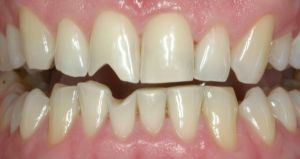 Injuries differ in the duration of exposure to the tooth of certain factors. Proceeding from this, traumas are chronic and aggravated. The difference is also in what teeth touched the destructive process - permanent or temporary, on this depends largely on the choice of methods of treatment.
Injuries differ in the duration of exposure to the tooth of certain factors. Proceeding from this, traumas are chronic and aggravated. The difference is also in what teeth touched the destructive process - permanent or temporary, on this depends largely on the choice of methods of treatment.
In addition, many dentists practice the division of injuries into dislocations, bruises and fractures of the teeth.
Classification depending on the stage of completeness of the formation of the root system:
- not formed;
- not formed just the root;
- completed formation processes.
Often, grasses are combined, for example, it may be incomplete dislocation and fracture of the root.
Symptoms and treatment of bruises
As for bruises, they represent a closed mechanical damage, which in the future is not the reason for the destruction of the integrity of the tooth. This form of trauma is characterized by damage to connective tissues. If there is a complete rupture of the neurovascular bundle, this leads to hemorrhage and further death of the pulp.
Symptoms:
- aching pain, worse with pressure;
- tooth is slightly mobile, but not critical;
- discomfort;
- crown becomes pink due to blood entering the pulp.
Methods of diagnosis and therapy
In order to diagnose this type of trauma, an anamnesis is required. Also important are signs, such as darkening of the crown, 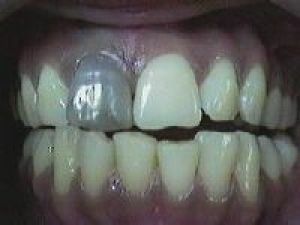 soreness of percussion and others. Instrumental data are also used.
soreness of percussion and others. Instrumental data are also used.
Radiography allows you to exclude fractures and see the expansion of the periodontal gap. In order to determine whether the pulp is viable, electrodontodiagnosis is performed.
Methods for resolving the problem:
- , the patient should be excluded from the affected area;
- eliminating the use of solid food;
- to exclude chewing on the side of the damaged tooth;
- grinding of the bumps and cutting edges of the tooth;
- is carried out physiotherapy;
- is prescribed anti-inflammatory and healing preparations;
- if the pulp is no longer viable, then it is extirpated and canalized.
Dislocations due to mechanical impact
As a result of dislocation, the tooth partially, and in some cases even completely, falls out of the well. This kind of injury occurs as a result of damage to the walls of the alveolus and separation or rupture of connective tissue.
Symptoms that accompany a dislocation:
- pain;
- falling out of the hole of the cutter;
- tool movement;
- discomfort when chewing or loss of tooth function;
- tooth dislocation;
- with bleeding connective tissue bleeding or pathological pockets;
- rupture or separation of connective tissue;
- bleeding an empty hole in which there is a blood clot( when completely dislocated);
- wounds and bruises on soft tissues.
Diagnosis and treatment of
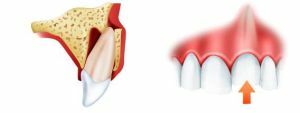 In this case, a significant role is played by clinical data, first of all, the absence or displacement of the tooth is detected. Also, the diagnosis is based on the X-ray.
In this case, a significant role is played by clinical data, first of all, the absence or displacement of the tooth is detected. Also, the diagnosis is based on the X-ray.
To clarify the position of the tooth and the condition of the alveolar bone, a radiovisiographic examination is performed. Experts resort to EDI to determine the viability of the pulp.
Treatment of dislocation:
- repositioning of the injured tooth and its further fixation for the bonding period;
- is prescribed antibacterial and anti-inflammatory therapy;
- if the pulp is no longer viable, endodontic therapy is performed;
- specialists resort to dental implantation or prosthetics with tooth loss or re-implantation;
- one-stage and long-term repositioning when the dislocation is pushed;
- in some cases, the tooth is removed with subsequent implantation or replacement with a prosthesis.
Fractures - complete and incomplete
This fracture is characterized by a fracture of the root and / or crown, or a fracture of part of the dentin or enamel.
Symptomatic symptomatology
A fracture of the tooth shape is characteristic. In this case, in the affected area, discomfort is felt accompanied by painful sensations.
In some cases, the tooth may be immobile, although it has changed its location in the process of injury.
Because of the fracture of the cutter, the sharp edges left after the cleavage shift can injure the mucous and soft tissues, that is, lips, tongue and others.
Diagnosis and treatment of
Diagnosis is based on inspection. Also, targeted radiography is performed in order to exclude or confirm fracture of the root. The condition of the pulp is determined by electrodontometry.
Methods of therapy: 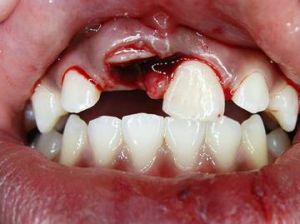
- broken crown of tooth - crown, restored by special means( composite materials, fixed crown or stump toothpaste are used);
- if the shape of the fracture is complicated, then probably the development of pulpitis, which requires immediate treatment;
- resuscitated injured incisor;
- , in some cases, the injured cutter is removed;
- is possible treatment in relation to the roots, then the fixed tooth is grinded.
Consequences and preventive measures
Possible consequences:
- removal of the damaged cutter;
- dying of pulp and its subsequent removal;
- inflammation in the cavity of the tooth;
- staining of the enamel or its darkening;
- over time can develop cyst, periodontitis and stop the development of the root system.
It is better to prevent than to treat later. Therefore, it is worth remembering that your teeth should be treated with care, in order to avoid the problems of 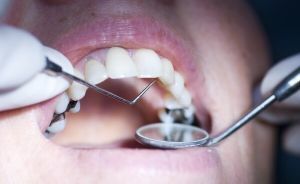 in the future.
in the future.
There are preventive measures that will preserve the integrity of the teeth:
- first and foremost you need a constant examination at the dentist, at least every six months;
- need to abandon bad habits;
- use of vitamins to strengthen the teeth;
- helmet use when operating under extreme conditions.
